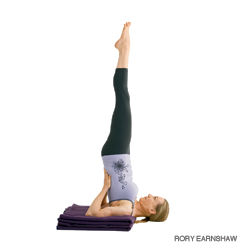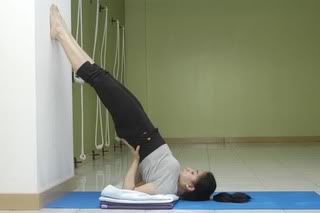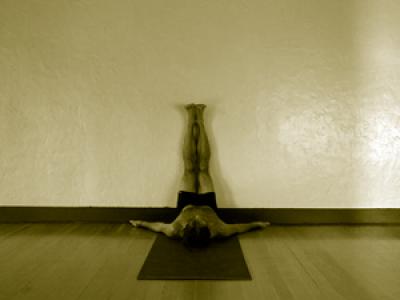Salamba Sarvangasana ~ Shoulder Stand
 This pose can be quite difficult and scary for people. For some, anytime we go upside down fear is exposed. Add to that the fear that you are putting a lot of pressure on the neck and many simply stay away from this pose. So, why would you want to do it? There are many benefits to sarvangasana: It helps to stimulate the thyroid and parathyroid; helps to reduce fatigue mild depression and stress; stretches the shoulders and neck; tones abs, legs and buttocks. Also, being upside down in any position gives your heart a bit of a break and brings more blood flow to the brain.Done correctly, you are standing on your shoulders rather than your neck. Start off lying on the floor with the arms extended alongside the body and the knees bent. Bring the knees in toward the chest and begin to lift the pelvis and back from the floor keeping knees bent at first. At this point you can bring the knees to the forehead in order to adjust your elbows if they happen to be flaring out from the side bodies. Draw should blades firmly together and bring hands to the low back. Slowly begin to extend the legs upward. For some, the legs can extend straight up over the shoulders. You will press the upper arms and shoulders firmly into the floor here, taking pressure off of the neck. A good way to practice is to place a folded blanket or towel underneath the shoulder blades, so the top of the blanket is at the top of the shoulders. This allows a little more space between the neck and the floor.There are modifications to salamba sarvangasana. One way to modify is to make more of a V with the legs, rather than extending fully, as shown here:
This pose can be quite difficult and scary for people. For some, anytime we go upside down fear is exposed. Add to that the fear that you are putting a lot of pressure on the neck and many simply stay away from this pose. So, why would you want to do it? There are many benefits to sarvangasana: It helps to stimulate the thyroid and parathyroid; helps to reduce fatigue mild depression and stress; stretches the shoulders and neck; tones abs, legs and buttocks. Also, being upside down in any position gives your heart a bit of a break and brings more blood flow to the brain.Done correctly, you are standing on your shoulders rather than your neck. Start off lying on the floor with the arms extended alongside the body and the knees bent. Bring the knees in toward the chest and begin to lift the pelvis and back from the floor keeping knees bent at first. At this point you can bring the knees to the forehead in order to adjust your elbows if they happen to be flaring out from the side bodies. Draw should blades firmly together and bring hands to the low back. Slowly begin to extend the legs upward. For some, the legs can extend straight up over the shoulders. You will press the upper arms and shoulders firmly into the floor here, taking pressure off of the neck. A good way to practice is to place a folded blanket or towel underneath the shoulder blades, so the top of the blanket is at the top of the shoulders. This allows a little more space between the neck and the floor.There are modifications to salamba sarvangasana. One way to modify is to make more of a V with the legs, rather than extending fully, as shown here: Another way to modify is to walk the legs up a wall:
Another way to modify is to walk the legs up a wall: Or even simply have the legs up the wall as shown here:
Or even simply have the legs up the wall as shown here: Full salamba sarvangasana should only be taken when you have a healthy neck and normal blood pressure. This is a more intermediate to advanced posture and it’s always wise to perform with a teacher to start.
Full salamba sarvangasana should only be taken when you have a healthy neck and normal blood pressure. This is a more intermediate to advanced posture and it’s always wise to perform with a teacher to start.